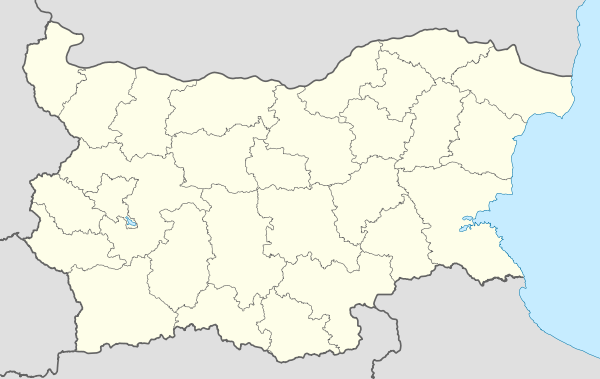Pobiti Kamani
| Pobiti Kamani | |
|---|---|
| The Stone Desert | |
|
Rock Formations | |
 Location within Bulgaria | |
| Location | Varna Province, Bulgaria |
| Nearest city | Aksakovo |
| Coordinates | 43°13′35″N 27°42′24″E / 43.22639°N 27.70667°ECoordinates: 43°13′35″N 27°42′24″E / 43.22639°N 27.70667°E |
| Area | 13 sq km (5 sq mi) |
Pobiti Kamani (Bulgarian: Побити камъни), also known as The Stone Desert, is a desert-like rock phenomenon located on the north west Varna Province border in Bulgaria. It is considered the only desert in Bulgaria and one of few found in Europe. The desert consists of sand dunes and several groups of natural rock formations on a total area of 13 km². The formations are mainly stone columns between 5 and 7 meters high and from 0.3 to 3 meters thick. The columns do not have solid foundations, but are instead hollow and filled with sand, and look as if they were stuck into the surrounding sand, which gives the phenomenon its name. Sandstorms and sand twisters have also been known to commonly occur in this desert region of Bulgaria. The Stone Desert is not only a well known European tourist attraction due to its desert like habitat, but it is one of few places where desert type vegetation such as cactus are known to grow. It is also the only desert in Europe in which desert reptilians and other desert type animalia are found to thrive. The Stone Desert along with the Tabernas Desert of Spain is one of two naturally formed deserts in all of Europe and the only known naturally formed desert in Eastern Europe.
In order to be preserved, Pobiti Kamani (The Stone Desert) was designated a natural landmark in the late 1930s. There are a number of theories regarding the phenomenon's origin. The pioneering hypothesis can be divided roughly into two groups: suggesting an organic or abiotic origin. According to the former, the formations are the result of coral activity (but detail investigation shows no coral), while the latter explain the phenomenon with the prismatic weathering and desertification of the rocks, the formation of sand and limestone concretions, or lower Eocene bubbling reefs.
Based on a petrographic and stable isotope geochemical study and field observations, evidence exists that these structures represent an exceptionally record of paleo-hydrocarbon seep system (low magnesium calcite cements are strongly depleted in heavy carbon isotope 13C). The pathways of fluid circulation are recorded as columns set in sands, which columns after recent sand removal gave desert-like landscape. The dynamic reconstruction of the origin of these structures, the processes of fluid migration and microbial mediation of hydrocarbon oxidation leading to carbonate precipitation have been studied by De Boever et al. (2009).
Gallery
References
- Dimitrov, Lyubomir. "Pobiti Kamani" (in Bulgarian). Varna-bg.com. Retrieved 2006-08-02.
- de Boever E., Birgel D., Thiel V., Muchez P., Peckmann J., Dimitrov L., Swennen R. 2009. The formation of giant tubular concretions triggered by anaerobic oxidation of methane as revealed by archaeal molecular fossils (Lower Eocene, Varna, Bulgaria. Palaeogeography, Palaeoclimatology, Palaeoecology 280, 23-36.
External links
| Wikimedia Commons has media related to Pobiti kamani. |





